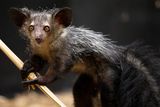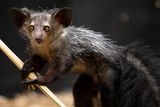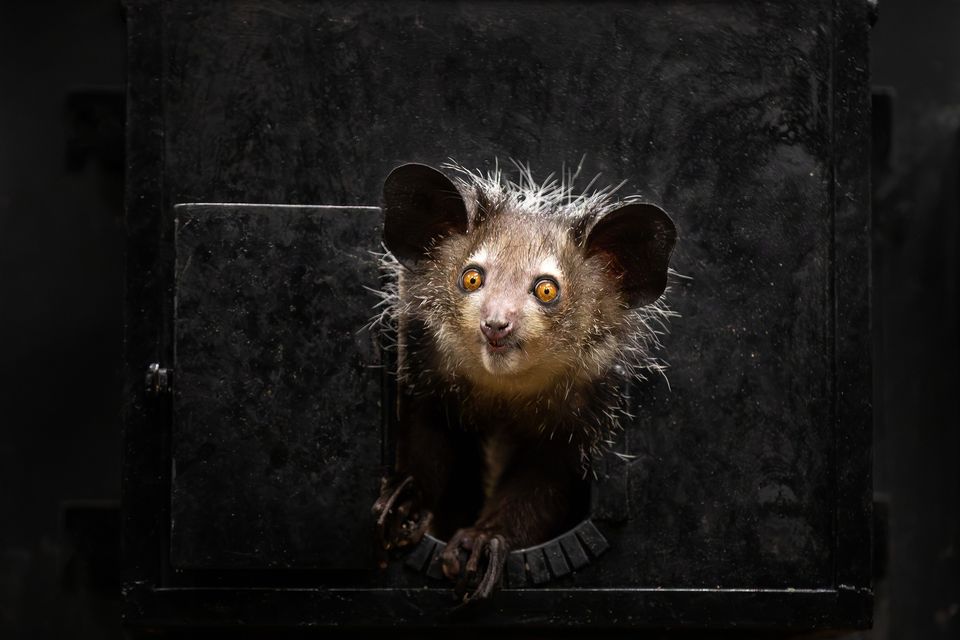Dublin Zoo welcomes first ever Aye-Aye lemurs to their new nocturnal habitat



Dublin Zoo has officially become home to a striking new lemur species, the Aye-Aye, native to the island of Madagascar.
The three new additions to the zoo – Peanut, Tahiti and their unnamed baby – are the first Aye-Aye in Ireland and get to enjoy their new nocturnal habitat at the zoo.
The visually striking animals have dark fur, a long bushy tail, large yellow eyes and slender fingers, including a long middle finger for foraging.
Visitors to Dublin Zoo met the Aye-Aye for the first time today in their new specially-built nocturnal hut, which mimics nighttime conditions.
Visitors to the habitat entered into complete darkness, guided by small lights in the ground to navigate and observe the animals.
Zookeeper Sarah Byrne said tending to the new arrivals must be done completely in the dark due to their nocturnal nature, which includes feeding and cleaning the enclosures in darkness.
Read more
“We work in the dark mostly, we provide these guys with a lot of insects and they have a very unique feeding strategy,” Ms Byrne said.
“We have to hide insects inside bamboo and logs for them to chew them out.
“They are super energetic. They bounce around, they are fast and quite noisy as well. So all of this is happening in the dark around you while you are trying to look after them.”
The zookeeper said the Aye-Aye is a smart animal, often grabbing radios and food on zookeepers and running up tree branches.
“They are very intelligent and we have to keep them occupied. They do keep us on our toes and get in everywhere they shouldn’t,” Ms Byrne said.
Dublin Zoo's newest resident, an Aye-Aye lemur, at the new nocturnal habitat
“We needed to make sure the enclosure is Aye-Aye proof. Peanut, our male, shocked us because he is always on the ground, always under your feet waiting at the door for you to come in with his food.
“They absolutely love walnuts in the shell, so if you tap one of those on a tree they instantly come over to the noise,” the zookeeper added.
One of the first to see the furry animals was Noreen Burke with her two children Ciaran Dorney (11) and Roisin Dorney (13), from Galway.
The family travelled up to Dublin Zoo at 7am and were delighted to see the new additions. “It was brilliant, they are quite big,” said Ciaran.
Roisin added: “It’s kind of creepy at the start because it is really dark, but you can look in and there was one standing there. They have really bushy tails and long fingers.”
Ms Burke said the trip was “definitely” worth it. “It’s lovely see all the work the zoo is doing for conservation. It’s wonderful,” she said.
The Aye-Aye are the largest nocturnal primate, related to monkeys, apes and even humans, however, they have become an endangered species on the International Union for Conservation of Nature’s Red List.
Dr Christoph Schweitzer, Director of Dublin Zoo, said other nocturnal species from Madagascar, such as jumping rats, may be added to the zoo in future.
Mr Schweitzer said 96pc of all lemurs are endangered and the zoo is planning to breed the new additions for conservation.
“There are 107 different lemur species in Madagascar. The Aye-Aye is the most ancient of all the lemur lineages which means it split off the evolutionary tree earlier than the other lemurs,” he said.
“It’s a very interesting creature, they are lovely animals, some people would probably say they are a bit peculiar.
“They are black and have this grizzly hair all over their body and a bushy tail, with large yellow eyes which enable them to see in the dark.
“They have a brilliant adaptation of an elongated middle finger they use for foraging.”
Due to the species being nocturnal, the zoo has reversed the light and dark cycle in the habitat to mimic nighttime during the day for visitors.
“It’s a unique experience that we haven’t had at Dublin Zoo before. People have to step into the dark,” Dr Christoph Schweitzer said.
The new nocturnal house was created with a €400,000 investment, partly funded through the Office of Public Works.
The habitat is now fully open to the public and educational workshops will run throughout the week at Dublin Zoo, with special keeper talks, crafts, games and face-painting.




